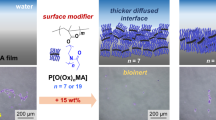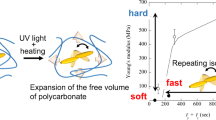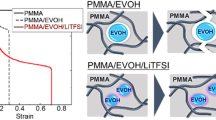Abstract
A new method to localize poly(methyl methacrylate) (PMMA) at the surface of a miscible blend with polycarbonate (PC) is demonstrated. Low-molecular-weight PMMA, which is found to be miscible with PC, is used in this study. After annealing the PC/PMMA blend in a temperature gradient, PMMA is found to localize on the high temperature side, as detected by infrared spectroscopy and molecular weight measurements. Furthermore, the sample exhibits good transparency even after annealing. This phenomenon is notable because it is applicable to enhancing the anti-scratch properties of PC.
Similar content being viewed by others
Introduction
Polycarbonate (PC) is widely employed in industrial applications, such as plastic glasses, optical discs and exterior cases for electronic equipment, because of its excellent transparency and mechanical toughness. In the automobile industry, PC is expected to be used rather than inorganic glass in future vehicles because of its light weight.
Although PC has good transparency and high impact resistance, its ability to resist scratches is poor. A hard-coating process1, 2 is generally required to overcome this problem; however, this process results in higher costs. In contrast, poly(methyl methacrylate) (PMMA) has a high surface hardness and transparency, although its mechanical toughness is considerably less than that of PC. Therefore, a multi-layered structure consisting of a thin surface layer composed of PMMA and a PC core is an ideal material because it possesses both anti-scratch properties and a high impact resistance. In fact, such a concept has already been proposed and employed in industry.3, 4
In this study, we propose a new method for producing transparent sheets in which PMMA is localized at the surface of a miscible blend of PC and PMMA. It has recently been reported that a polymer with a broad molecular weight distribution exhibits molecular weight segregation in the molten state under large temperature gradients. Although this phenomenon appears to be similar to the Soret effect,5, 6 the segregation occurs even at very high viscosity. According to Siriprumpoonthum et al.,7 the molecular weight segregation of a polymer occurs due to the difference in the free volume fraction. Because low-molecular-weight components have a large free volume at the chain ends, they migrate to the high temperature region. This phenomenon is expected to occur in a miscible blend system. Because PC is known to be miscible with low-molecular-weight PMMA,8, 9, 10 the blend exhibits segregation behavior across a temperature gradient, and the PMMA tends to localize at the surface at high temperature.
Experimental procedure
Materials and sample preparation
A commercially available bisphenol A PC (Panlite L-1225Y, Teijin, Osaka, Japan) was used in this study. Furthermore, two types of PMMA with different molecular weights were employed: a commercially available grade, H-PMMA (Acrypet VH, Mitsubishi Rayon, Tokyo, Japan) and a second type kindly provided by Mitsubishi Rayon (L-PMMA). The molecular weights of the polymers were Mn=28 000 and Mw=46 000 for PC, Mn=58 000 and Mw=120 000 for H-PMMA and Mn=8900 and Mw=15 000 for L-PMMA.
Melt mixing of PC/H-PMMA and PC/L-PMMA was performed in a 30 cm3 batch-type internal mixer (Labo-Plastmill, Toyoseiki, Tokyo, Japan) at 240 °C. The rotation speed of the blades was 30 r.p.m., and the mixing time was 3 min. The amount of PMMA in the blends was 20 wt%.
The blends were compressed into flat sheets with thicknesses of 0.3 and 3 mm by a compression-molding machine (SA303IS, Tester Sangyo, Saitama, Japan) for 3 min at 250 °C under 10 MPa and subsequently quenched at 25 °C.
The 3-mm thick sheets were annealed in a molten state in the compression-molding machine for 15, 30, 60 and 180 min, during which the temperatures of the top and bottom plates were controlled separately. After the annealing treatment in the temperature gradient, the sheets were immediately quenched at 10 °C.
Measurements
The temperature dependence of oscillatory tensile moduli, such as the storage modulus E′ and the loss modulus E″, were measured from 30 to 180 °C using a dynamic mechanical analyzer (E4000, UBM, Kyoto, Japan). The frequency and heating rate were 10 Hz and 2 °C min−1, respectively. A rectangular specimen, 5 mm wide, 10 mm long and 0.3 mm thick, was excised from the compressed sheets. The effect of added PMMA on the transmitted light intensity was investigated using a UV–Vis spectrometer (Lambda 25, Perkin-Elmer, Yokohama, Japan) with the 0.3-mm thick sheets.
The surface of the sheets was characterized by attenuated total reflectance Fourier transform infrared spectroscopy (ATR-FTIR; Spectrum 100 FT-IR spectrometer, Perkin-Elmer) at room temperature using KRS-5 as an ATR crystal. The refractive index of KRS-5 is 2.5. Before the measurements, the sample was kept in an incubator at 25 °C under vacuum for 6 h.
The molecular weight and its distribution were evaluated using a size exclusion chromatograph (HLC-8020, Tosoh, Tokyo, Japan) with TSK-GEL GMHXL, in which chloroform was employed as a solvent at 40 °C at a flow rate of 1.0 ml min−1. The sample concentration was 1.0 mg ml−1. Standard polystyrene was used to calibrate the molecular weight. For the measurements of the sheet surface, the samples were collected by grinding using a metal file to a depth of ~50 μm.
Results and discussion
Miscibility
Figure 1 shows the temperature dependence of the tensile storage modulus E′ and the loss modulus E″ of (a) pure polymers and (b) blends containing 20 wt% PMMA. All samples were compressed at 250 °C. As shown in this figure, the storage modulus sharply decreased because of the glass-to-rubber transition. Correspondingly, the loss modulus showed a maximum, which can be considered the glass transition temperature, Tg. The Tgs for PC, H-PMMA and L-PMMA are 162, 115 and 97 °C, respectively. The Tg of L-PMMA is lower than that of H-PMMA. This result is reasonable because L-PMMA has a low molecular weight.11 Furthermore, the temperature range employed in this experiment was restricted for L-PMMA because of the mechanical brittleness, which is also attributed to the low molecular weight.
Temperature dependence of the dynamic tensile moduli, such as (closed symbols) storage modulus E′ and (open symbols) loss modulus E″, at 10 Hz for (a) pure polymers, (circles) pure polycarbonate (PC), (squares) pure H-poly(methyl methacrylate) (PMMA) and (triangles) pure L-PMMA, and for (b) blends (circles) PC/H-PMMA (80/20) and (triangles) PC/L-PMMA (80/20).
For PC/H-PMMA (80/20), there are two peaks at 118 and 161 °C in the E″ curve, which are attributed to the Tgs of H-PMMA and PC, respectively. In contrast, PC/L-PMMA (80/20) showed a single peak, located at the temperature between the Tgs of PC and L-PMMA. These results suggest that L-PMMA is miscible with PC.
It is well known that the Tg of a polymer blend is predicted by the following Fox equation (equation (1)).12

where wi is the weight fraction of the i-th component and Tgi is the glass transition temperature of the i-th component. Because phase separation occurred, the experimental Tg at the higher temperature for PC/H-PMMA (80/20), 161 °C, is higher than the predicted value, 152 °C. In contrast, the experimental value for PC/L-PMMA (80/20) of 144 °C is consistent with the calculated value. These results are as expected because L-PMMA is miscible with PC, whereas H-PMMA is immiscible with PC. The effect of molecular weight on the miscibility has been reported using PC/PMMA blends, and the results are consistent with the present results.8, 9, 10
PC/PMMA blends are known to possess a lower critical solution temperature.9, 10, 13 Therefore, the mixing and processing temperatures affect their miscibility. In this study, the effect of temperature on the miscibility was evaluated by the light transmittance of the 0.3-mm thick sheets that were compressed at various temperatures. Figure 2 shows the light transmittance in the visible region for sheets compressed at 250 °C, that is, the same samples used for the dynamic mechanical measurements. Pure PC, pure PMMA and PC/L-PMMA (80/20) exhibit good transparency. However, PC/H-PMMA (80/20) shows low transmittance. In fact, the sheet is opaque. The light scattering from the separated phases with different refractive indices is responsible for the opaque nature. This result is consistent with the dynamic mechanical analysis.
Figure 3 presents the light transmittance for PC/L-PMMA (80/20) sheets compressed at various temperatures. The transmittance of the blend sheet was greatly reduced at 300 °C. This result was expected because PC/PMMA blends are characterized by a lower critical solution temperature-type phase diagram. In contrast, a high level of light transmittance was detected at 200 and 250 °C. This result indicates that L-PMMA is miscible with PC in the temperature region below 250 °C at this blend ratio.
Segregation behavior
Figure 4 shows the ATR-FTIR spectra at both surfaces of PC/L-PMMA (80/20) annealed in the compression-molding machine, in which the top and bottom plates were set at 250 and 200 °C, respectively. The gap between the plates, that is, the film thickness was 3.0 mm. Therefore, the temperature gradient was 17 °C mm−1. The sample was annealed for 60 min. The annealed sample was in the miscible state because the sheet maintains transparency even after the annealing treatment. Consequently, annealing does not change the light transmittance. The ATR-FTIR spectrum of the non-annealed sample compressed at 250 °C is also shown in Figure 4. The composition of the surface at 200 °C is almost identical to that of the non-annealed sample, indicating that segregation barely occurs in this region because of the high viscosity at this temperature.
Attenuated total reflectance Fourier transform infrared spectroscopy spectra for polycarbonate/L-poly(methyl methacrylate) (80/20) compressed at 250 °C; (circles) without post-processing annealing, (dashed line) the high temperature side and (solid line) the low temperature side after annealing under the temperature gradient (200–250 °C) for 60 min.
The peak at 1770 cm−1 is attributed to the C=O stretch vibration of PC, and the peak at 1730 cm−1 is the C=O stretch vibration of PMMA. The penetration depth (dp) in the region from 1730 to 1770 cm−1 is ~1.2 μm, as calculated using equation (2).

where λ is the wavelength of the infrared beam; n1 and n2 are the refractive indices of the sample and the ATR crystal, respectively; and θ is the incidence angle of the infrared beam.
The surface on the high temperature side has a stronger absorbance at 1730 cm−1 and a weaker absorbance at 1770 cm−1. In contrast, the peak intensities are the opposite on the low temperature side. These results demonstrate that the PMMA concentration increases at the high temperature side and vice versa, although the components are miscible in the experimental temperature range. This result demonstrates that segregation behavior of L-PMMA in the blend occurs in the temperature gradient.
Figure 5 shows the PMMA content at the surface at 250 °C for the PC/L-PMMA (80/20) annealed for various annealing periods. The PMMA content increased with annealing time and appeared to show an equilibrium value after 60 min. The content in the equilibrium state was ~30 wt%, which was estimated from a calibration curve obtained by the ATR-FTIR measurements using the non-annealed PC/L-PMMA blends with various amounts of L-PMMA. The equilibrium content of L-PMMA can be determined by the contributions from both temperature-gradient segregation and diffusion induced by the concentration gradient.
Figure 6 shows the ATR-FTIR spectra at both surfaces of PC/L-PMMA (80/20). The top and bottom plates were set at 300 and 200 °C, respectively. Therefore, the temperature gradient was 33 °C mm−1. After annealing for 60 min, the sample became opaque as a result of phase separation.
It is believed that the segregation behavior clearly occurs across the large temperature gradient, considering the previous study using a single polymer with a broad molecular weight distribution.7 However, the intensities of neither peak change significantly. This result indicates that segregation does not occur significantly in the phase-separated blend.
Figure 7 shows the size exclusion chromatographs of samples collected from the surface of a PC/L-PMMA (80/20) sheet annealed at a temperature gradient of 250–200 °C compared with the bulk sample. The data for pure PC and L-PMMA are also shown. Apparently, the molecular weight of the surface sample at 250 °C is low, which is consistent with the ATR-FTIR results.
Size exclusion chromatographs of (solid line) pure polycarbonate (PC), (dashed line) pure L-poly(methyl methacrylate) (PMMA), (triangles) non-annealed PC/L-PMMA (80/20) and both surfaces ((crosses) 250 °C and (circles) 200 °C) for PC/L-PMMA (80/20) annealed under the temperature gradient for 60 min.
The experimental results revealed that segregation behavior occurs in the temperature gradient not only in a single polymer with a broad molecular weight distribution but also in the miscible blend. It is difficult to arrive at a detailed mechanism for the segregation phenomenon from the current experimental results. However, considering a previous report7 on the segregation behavior in the temperature gradient for polyethylene blends, the difference in the molecular weight, that is, the concentration of chain ends, could be responsible for the segregation in the temperature gradient. Furthermore, a difference in the free volume fraction between the individual polymers, attributed to the difference in Tg, could be another reason for the segregation.
Although the exact mechanism is unknown, this is the first report that miscible blends exhibit segregation in a temperature gradient. The results of this study may potentially be of significant interest to the polymer processing industry because PMMA has excellent surface properties, such as anti-scratch properties and hardness.
References
Hwang, D. K., Moon, J. H., Shul, Y. G., Jung, K. T., Kim, D. H. & Lee, D. W. Scratch resistant and transparent UV-protective coating on polycarbonate. J. Sol-Gel Sci. Technol. 26, 783–787 (2003).
Sowntharya, L., Lavanya, S., Ravi Chandra, G., Hebalkar, N. Y. & Subasri, R. Investigations on the mechanical properties of hybrid nanocomposite hard coatings on polycarbonate. Ceramics Int. 38, 4221–4228 (2012).
Walley, S. M., Field, J. E., Blair, P. W. & Milford, A. J. The effect of temperature on the impact behaviour of glass/polycarbonate laminates. Int. J. Impact Eng. 30, 31–53 (2004).
Scholtyssek, S., Seydewitz, V., Adhikari, R., Pfeifer, F., Michler, G. H. & Siesler, H. W. Influence of laminate thickness reduction on the deformation mechanism of coextruded multilayered PC/PMMA films. J. Appl. Polym. Sci. 127, 4262–4272 (2013).
Polyakov, P., Rossinsky, E. & Wiegand, S. Study of the Soret effect in hydrocarbon chain/aromatic compound mixtures. J. Phys. Chem. B 113, 13308–13312 (2009).
Maeda, Y. T., Buguin, A. & Libchaber, A. Thermal separation: Interplay between the Soret effect and entropic force gradient. Phys. Rev. Lett. 107, 038301 (2011).
Siriprumpoonthum, M., Mieda, N., Nobukawa, S. & Yamaguchi, M. Segregation behavior of polyethylene with broad molecular weight distribution by annealing procedure in temperature gradient. J. Polym. Res. 18, 2449–2453 (2011).
Marco, C., Fatou, J. G., Gomez, M. A., Tanaka, H. & Tonelli, A. E. Polycarbonate-poly(methyl methacrylate) blends: the role of molecular interactions on miscibility and antiplasticization. Macromolecules 23, 2183–2188 (1990).
Butzbach, G. D. & Wendorff, J. H. Polycarbonate-poly(methyl methacrylate) blends: the role of molecular interactions on miscibility and antiplasticization. Polymer 32, 1155–1159 (1991).
Nishimoto, M., Keskkula, H. & Paul, D. R. Role of slow phase separation in assessing the equilibrium phase behavior of PC-PMMA blends. Polymer 32, 272–278 (1991).
Fox, T. G. & Ferry, P. J. Second-order transition temperatures and related properties of polystyrene. 1. Influence of molecular weight. J. Appl. Phys. 21, 581–591 (1950).
Fox, T. G. Influence of diluent and of copolymer composition on the glass temperature of a polymer system. Bull. Am. Phys. Soc. 1 123, 123–127 (1956).
Kim, M. H., Kim, J. H., Kim, C. K., Kang, Y. S., Park, H. C. & Won, J. O. Control of phase separation behavior of PC/PMMA blends and their application to the gas separation membranes. J. Polym. Sci. B: Polym. Phys. 37, 2950–2959 (1999).
Acknowledgements
This work is partly supported by a grant from the Suzuki Foundation.
Author information
Authors and Affiliations
Corresponding author
Rights and permissions
About this article
Cite this article
Sako, T., Nobukawa, S. & Yamaguchi, M. Surface localization of poly(methyl methacrylate) in a miscible blend with polycarbonate. Polym J 47, 576–579 (2015). https://doi.org/10.1038/pj.2015.37
Received:
Revised:
Accepted:
Published:
Issue Date:
DOI: https://doi.org/10.1038/pj.2015.37
This article is cited by
-
Sum frequency generation imaging for semi-crystalline polymers
Polymer Journal (2022)
-
Improvement of mechanical toughness of polypropylene by laminating with elastomer
Journal of Polymer Research (2019)
-
Surface segregation during injection molding of polycarbonate/poly(methyl methacrylate) blend
Journal of Polymer Research (2017)










